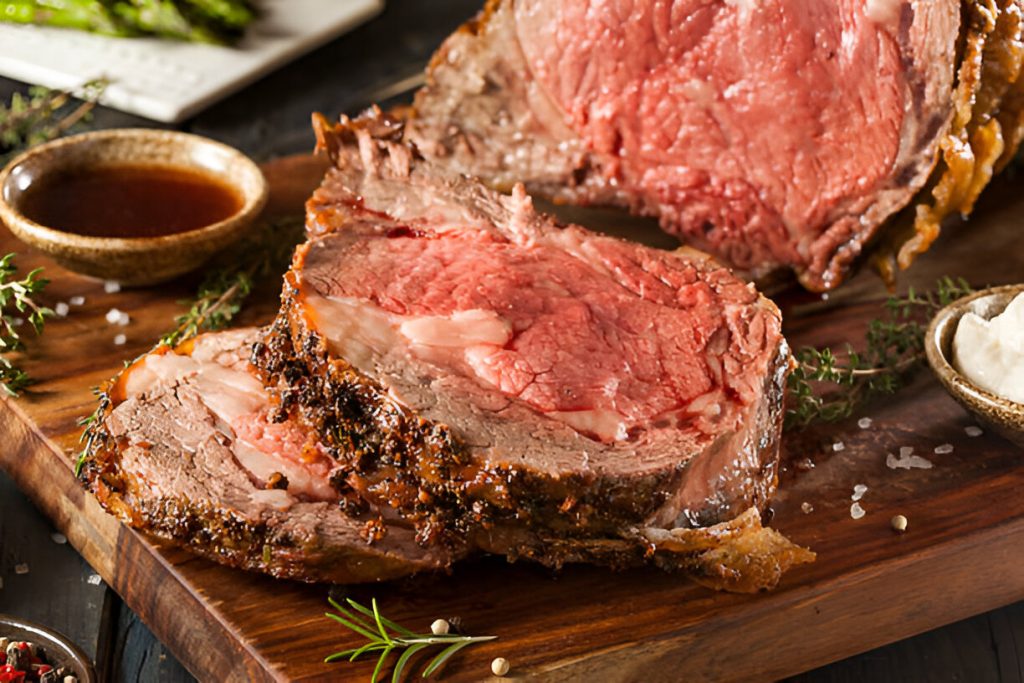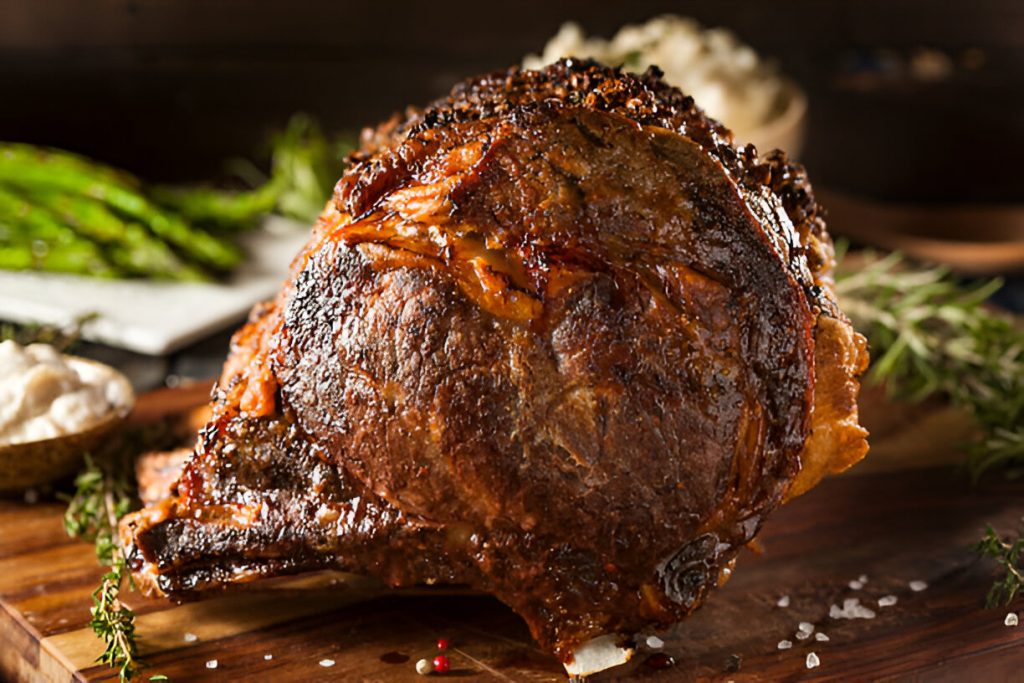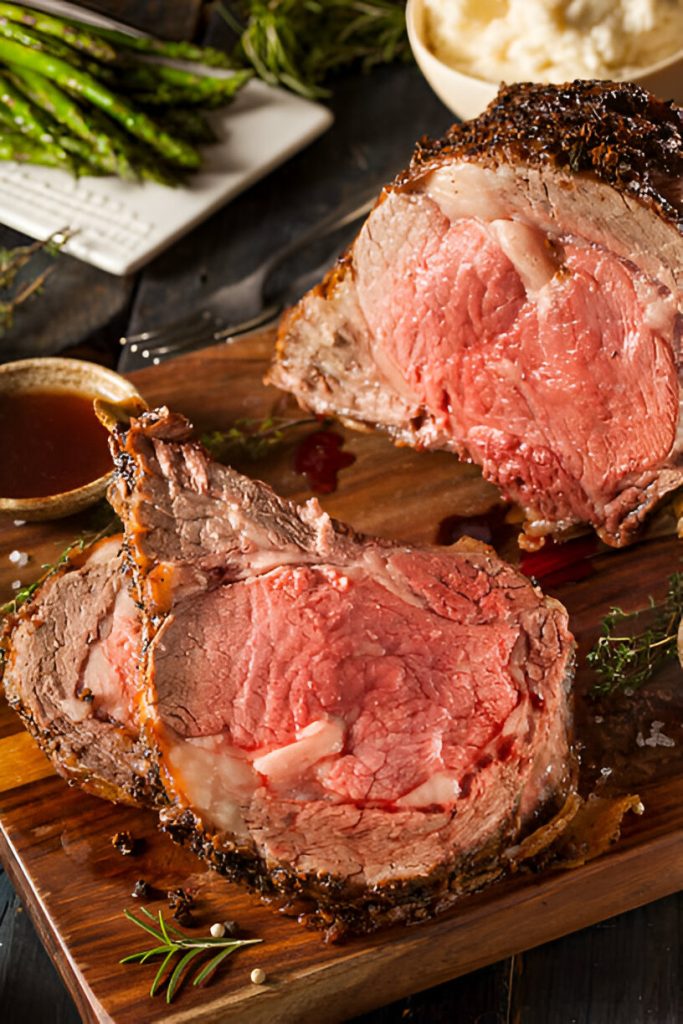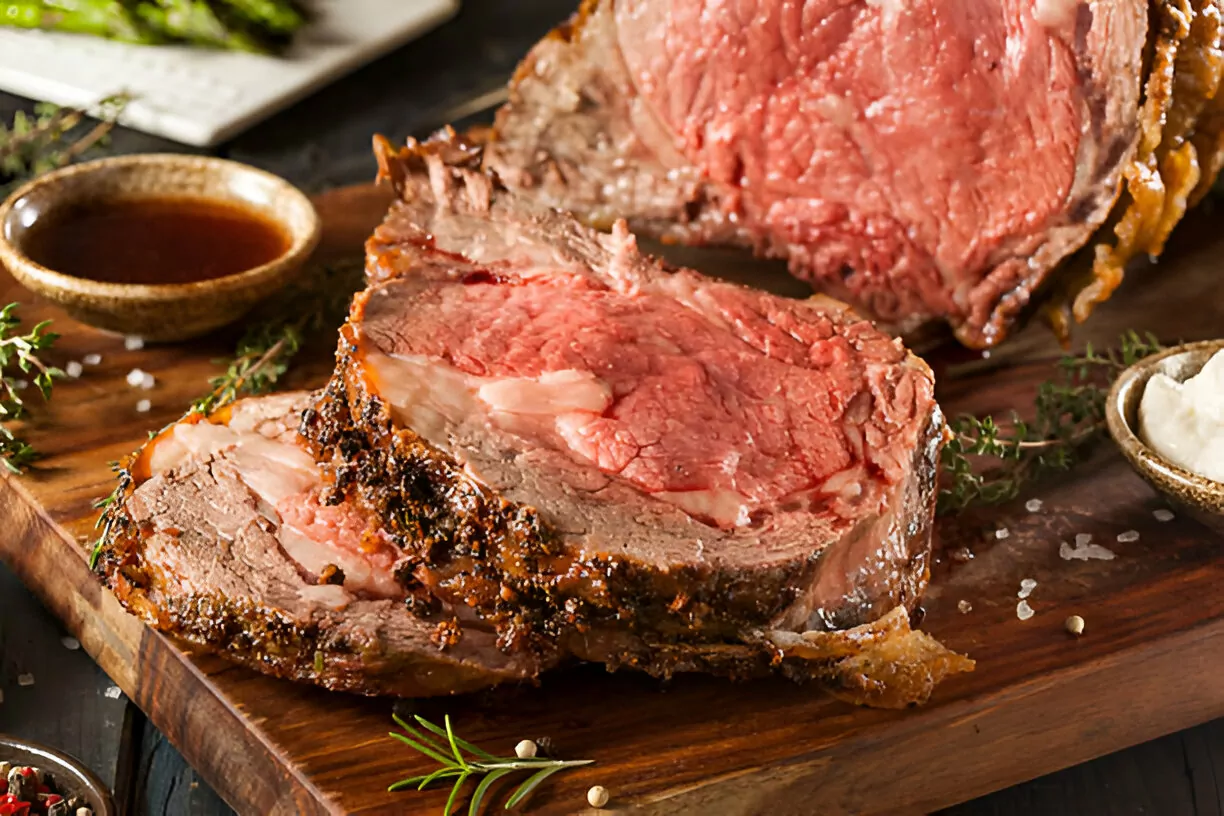Prime rib roast is an iconic, luxurious main dish, ideal for festive gatherings and special occasions. Its robust flavors, tender texture, and rich, savory aroma make it a show-stopping centerpiece that’s sure to impress. This roast combines a marbled prime rib cut with aromatic herbs, garlic, and a slow roasting method to ensure every slice is juicy and flavorful.

Ingredients and Preparation Essentials
The foundation of this dish lies in a high-quality, bone-in prime rib roast, which brings an impressive amount of flavor and tenderness. A seasoning blend of kosher salt, fresh thyme, rosemary, minced garlic, and black pepper highlights the meat’s natural richness. Olive oil adds moisture, while onions, used as a bed in the roasting pan, lend a subtle sweetness and deepen the flavor profile as they caramelize during roasting.
For a memorable prime rib roast, selecting the right cut is essential. A bone-in roast adds flavor and helps the meat retain its moisture while cooking. Look for a roast with a generous layer of fat and well-distributed marbling, as this will enhance the meat’s succulence and richness. The fat cap on top allows for natural basting, creating a beautifully browned crust while keeping the interior juicy and tender.
Step-by-Step Instructions for Perfect Prime Rib Roast
Preparing the Roast for Marinating
Begin by rinsing the roast under cold water and patting it dry thoroughly with paper towels. Place a flat roasting rack inside a large roasting pan and spread a layer of sliced onions across the rack. If a rack is unavailable, position the roast directly on the onions. This setup allows for optimal air circulation and adds a delicate, caramelized flavor to the meat.
Applying the Seasoning Rub
Create a flavorful rub by combining kosher salt, black pepper, minced garlic, fresh rosemary, fresh thyme, and olive oil in a bowl. Massage this aromatic blend over the roast, ensuring that every inch of the meat is evenly coated. The herbs and garlic infuse the meat with a deep, savory aroma, while the salt draws out moisture, enhancing the flavor.
Marinating and Resting for Best Flavor
To allow the seasoning to permeate the meat, wrap the roast in plastic wrap and let it marinate in the refrigerator for at least eight hours, or overnight. This step infuses the outer layers of the roast with aromatic flavors. Remove the roast from the refrigerator at least two hours before cooking to bring it to room temperature, which ensures even cooking. For larger, bone-in roasts, allowing it to sit out for six to eight hours is ideal.
Roasting for Perfect Browning and Tenderness
Preheat your oven to 450°F (230°C). Place the roast on a lower oven rack and roast for 30 minutes. Afterward, add a half-cup of water to the pan to prevent the onions from burning. Continue roasting for an additional 30 minutes, rotating the roast 180° if necessary to achieve even browning. Once browned on the outside, lower the oven temperature to 350°F (175°C) and continue roasting. Baste the roast every 30 minutes, and add water to the pan as needed to keep it from drying out.
Resting and Preparing the Au Jus
Once the roast reaches your desired doneness, transfer it to a cutting board or serving platter. Tent it with aluminum foil and let it rest for 15 to 20 minutes to allow the juices to redistribute. While the roast rests, strain the pan juices through a fine-mesh strainer into a fat separator. Pour the defatted juices into a small saucepan, warming it over low heat to create an au jus. If it’s too concentrated, dilute it with hot water to taste.

Recipe Tips
Achieving Ideal Doneness
Use a meat thermometer for accuracy, aiming for 125°F (51°C) for medium-rare.
Preventing Char on the Roast
If the top starts to char, cover it with foil to protect the exterior without affecting the rest.
Flavor Enhancements
Consider adding a hint of smoked paprika or extra garlic for a bolder flavor profile.
What to Serve With This Recipe
Complementary Side Dishes
Serve your prime rib with traditional sides like creamy mashed potatoes, sautéed green beans, and roasted carrots. These accompaniments balance the roast’s richness and add color to the plate.
Flavorful Condiments and Sauces
Prime rib pairs beautifully with horseradish sauce or a creamy mustard. A dollop of the au jus on the side completes the dish, adding moisture and enhancing the meat’s savory flavors.
Frequently Asked Questions
Can I Make This Recipe with a Boneless Roast?
A boneless roast cooks slightly faster, so adjust cooking time accordingly. The flavor remains robust, but the bone-in version provides added richness.
How Do I Store and Reheat Leftover Prime Rib?
Store leftovers in an airtight container in the fridge. For reheating, gently warm the slices in a low oven to maintain their juiciness.
What’s the Best Way to Ensure Even Cooking?
Allowing the roast to reach room temperature before cooking and rotating it during roasting helps achieve a uniform cook.
Can I Use Different Herbs or Seasonings?
Experiment with sage, oregano, or smoked paprika for unique flavor twists that complement the prime rib.
Customizing for Special Occasions
Festive Seasonings and Garnishes
Incorporate seasonal herbs or sprinkle fresh parsley on top before serving for an elevated holiday presentation.
Creative Serving Presentations
Display the roast on a rustic wooden board with garnishes of fresh rosemary sprigs, parsley, and a few roasted garlic cloves for an elegant centerpiece.
Try this prime rib recipe for a meal that’s sure to impress family and friends. Its bold flavors, tender texture, and versatile presentation make it ideal for gatherings and special celebrations, ensuring a memorable dining experience. Enjoy this classic dish with your favorite sides and sauces for a complete, satisfying feast.

Ingredients
A bone-in prime rib roast
1 teaspoon fresh rosemary per pound/450g of roast
1 teaspoon minced garlic per pound/450g
1 teaspoon Kosher or coarse sea salt per pound/450g
1 teaspoon fresh thyme per pound/450g
1/2 teaspoon olive oil per pound/450g
1/3 medium onion (per pound), thickly sliced or diced
1/2 teaspoon freshly ground black pepper per pound/450g
Instructions
Ensure your prime rib roast has a nice layer of fat on top for natural basting. Rinse the roast under cold water, then pat it dry with paper towels to prepare for marinating.
Position a flat roasting rack inside a large roasting pan to accommodate your roast. Spread the onions across the rack. If you don’t have a roasting rack, you can place the roast directly on the onions. Place the roast in the pan.
In a bowl, combine salt, pepper, garlic, rosemary, thyme, and olive oil to create a seasoning blend. Use your hands to thoroughly rub this mixture over the roast, ensuring an even coating across the surface.
Cover the roast with plastic wrap, and let it marinate overnight (at least 8 hours) in the refrigerator. This allows the flavors to penetrate the fat cap, infusing the roast with rich flavors.
Take the roast out of the refrigerator at least 2 hours before cooking to allow it to reach room temperature. For best results with bone-in roasts, consider leaving it out for 6 to 8 hours. Preheat your oven to 450°F (230°C). Position the roast on a lower oven rack, particularly for bone-in roasts; placing it too high may cause premature browning.
Roast for 30 minutes, then add 1/2 cup of water to the bottom of the pan to prevent the onions from burning. This allows them to caramelize and contribute to the roast’s flavor.
Continue roasting for another 30 minutes, checking for even browning. Rotate the roast 180° if necessary, positioning any unbrowned fatty areas toward the oven’s center. Once the outside is well-browned (approximately 1 hour in total), reduce the heat to 350°F (175°C).
Roast for an additional 90 to 120 minutes, basting every 30 minutes if desired. Add 1/2 cup of hot water as needed to prevent the pan from drying out.
A general guideline is to roast for about 15 minutes per pound. For a 12-pound roast, aim for a total cooking time of 180 minutes: 60 minutes at 450°F and 120 minutes at 350°F. These times are approximate; use a meat thermometer to avoid overcooking. For medium-rare, roast until the internal temperature reaches 125°F (51°C). For rarer doneness, remove the roast at 120°F (49°C) or even 115°F (46°C) for very rare. The meat will continue to cook slightly while resting.
If the top begins to char, cover it lightly with foil, leaving the sides exposed. Rotate the roast 180° if necessary to ensure even cooking.
Once done, transfer the prime rib to a cutting board or serving platter. Tent it with aluminum foil and let it rest for 15 to 20 minutes. Meanwhile, strain the pan juices through a fine-mesh strainer into a fat separator. If more liquid is needed, add 1/2 cup of water to the hot pan, stirring to release any flavorful bits.
Pour the separated juices into a small pot or sauté pan and warm them as au jus for serving. Dilute with hot water to taste if the au jus is too concentrated. Serve the prime rib with au jus on the side, and add horseradish if desired.

Prime Rib Roast Recipe
Ingredients
- A bone-in prime rib roast
- 1 teaspoon fresh rosemary per pound/450g of roast
- 1 teaspoon minced garlic per pound/450g
- 1 teaspoon Kosher or coarse sea salt per pound/450g
- 1 teaspoon fresh thyme per pound/450g
- 1/2 teaspoon olive oil per pound/450g
- 1/3 medium onion per pound, thickly sliced or diced
- 1/2 teaspoon freshly ground black pepper per pound/450g
Instructions
- Ensure your prime rib roast has a nice layer of fat on top for natural basting. Rinse the roast under cold water, then pat it dry with paper towels to prepare for marinating.
- Position a flat roasting rack inside a large roasting pan to accommodate your roast. Spread the onions across the rack. If you don’t have a roasting rack, you can place the roast directly on the onions. Place the roast in the pan.
- In a bowl, combine salt, pepper, garlic, rosemary, thyme, and olive oil to create a seasoning blend. Use your hands to thoroughly rub this mixture over the roast, ensuring an even coating across the surface.
- Cover the roast with plastic wrap, and let it marinate overnight (at least 8 hours) in the refrigerator. This allows the flavors to penetrate the fat cap, infusing the roast with rich flavors.
- Take the roast out of the refrigerator at least 2 hours before cooking to allow it to reach room temperature. For best results with bone-in roasts, consider leaving it out for 6 to 8 hours. Preheat your oven to 450°F (230°C). Position the roast on a lower oven rack, particularly for bone-in roasts; placing it too high may cause premature browning.
- Roast for 30 minutes, then add 1/2 cup of water to the bottom of the pan to prevent the onions from burning. This allows them to caramelize and contribute to the roast’s flavor.
- Continue roasting for another 30 minutes, checking for even browning. Rotate the roast 180° if necessary, positioning any unbrowned fatty areas toward the oven’s center. Once the outside is well-browned (approximately 1 hour in total), reduce the heat to 350°F (175°C).
- Roast for an additional 90 to 120 minutes, basting every 30 minutes if desired. Add 1/2 cup of hot water as needed to prevent the pan from drying out.
- A general guideline is to roast for about 15 minutes per pound. For a 12-pound roast, aim for a total cooking time of 180 minutes: 60 minutes at 450°F and 120 minutes at 350°F. These times are approximate; use a meat thermometer to avoid overcooking. For medium-rare, roast until the internal temperature reaches 125°F (51°C). For rarer doneness, remove the roast at 120°F (49°C) or even 115°F (46°C) for very rare. The meat will continue to cook slightly while resting.
- If the top begins to char, cover it lightly with foil, leaving the sides exposed. Rotate the roast 180° if necessary to ensure even cooking.
- Once done, transfer the prime rib to a cutting board or serving platter. Tent it with aluminum foil and let it rest for 15 to 20 minutes. Meanwhile, strain the pan juices through a fine-mesh strainer into a fat separator. If more liquid is needed, add 1/2 cup of water to the hot pan, stirring to release any flavorful bits.
- Pour the separated juices into a small pot or sauté pan and warm them as au jus for serving. Dilute with hot water to taste if the au jus is too concentrated. Serve the prime rib with au jus on the side, and add horseradish if desired.



